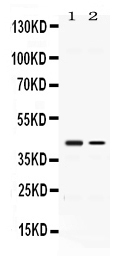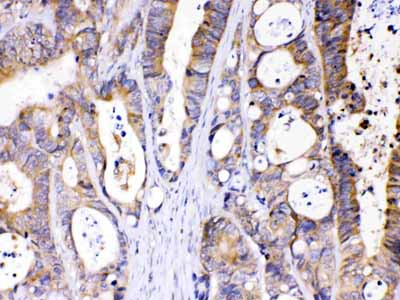Anti-Abhd5 Picoband Antibody
- SPECIFICATION
- CITATIONS
- PROTOCOLS
- BACKGROUND

Application
| WB, IHC-P |
|---|---|
| Primary Accession | Q8WTS1 |
| Host | Rabbit |
| Reactivity | Human, Rat |
| Clonality | Polyclonal |
| Format | Lyophilized |
| Description | Rabbit IgG polyclonal antibody for 1-acylglycerol-3-phosphate O-acyltransferase ABHD5(ABHD5) detection. Tested with WB, IHC-P in Human;Rat. |
| Reconstitution | Add 0.2ml of distilled water will yield a concentration of 500ug/ml. |
| Gene ID | 51099 |
|---|---|
| Other Names | 1-acylglycerol-3-phosphate O-acyltransferase ABHD5, 2.3.1.51, Abhydrolase domain-containing protein 5, Lipid droplet-binding protein CGI-58, ABHD5, NCIE2 |
| Calculated MW | 39096 MW KDa |
| Application Details | Immunohistochemistry(Paraffin-embedded Section), 0.5-1 µg/ml, Human, By Heat Western blot, 0.1-0.5 µg/ml, Human, Rat |
| Subcellular Localization | Cytoplasm . Lipid droplet . Colocalized with PLIN and ADRP on the surface of lipid droplets. The localization is dependent upon the metabolic status of the adipocytes and the activity of PKA (By similarity). . |
| Tissue Specificity | Widely expressed in various tissues, including lymphocytes, liver, skeletal muscle and brain. Expressed by upper epidermal layers and dermal fibroblasts in skin, hepatocytes and neurons (at protein level). . |
| Protein Name | 1-acylglycerol-3-phosphate O-acyltransferase ABHD5 |
| Contents | Each vial contains 5mg BSA, 0.9mg NaCl, 0.2mg Na2HPO4, 0.05mg NaN3. |
| Immunogen | E. coli-derived human Abhd5 recombinant protein (Position: R169-D349). Human Abhd5 shares 96.7% amino acid (aa) sequence identity with both mouse and rat Abhd5. |
| Purification | Immunogen affinity purified. |
| Cross Reactivity | No cross reactivity with other proteins |
| Storage | At -20˚C for one year. After r˚Constitution, at 4˚C for one month. It˚Can also be aliquotted and stored frozen at -20˚C for a longer time.Avoid repeated freezing and thawing. |
| Name | ABHD5 (HGNC:21396) |
|---|---|
| Synonyms | NCIE2 |
| Function | Coenzyme A-dependent lysophosphatidic acid acyltransferase that catalyzes the transfer of an acyl group on a lysophosphatidic acid (PubMed:18606822). Functions preferentially with 1-oleoyl- lysophosphatidic acid followed by 1-palmitoyl-lysophosphatidic acid, 1- stearoyl-lysophosphatidic acid and 1-arachidonoyl-lysophosphatidic acid as lipid acceptor. Functions preferentially with arachidonoyl-CoA followed by oleoyl-CoA as acyl group donors (By similarity). Functions in phosphatidic acid biosynthesis (PubMed:18606822). May regulate the cellular storage of triacylglycerol through activation of the phospholipase PNPLA2 (PubMed:16679289). Involved in keratinocyte differentiation (PubMed:18832586). Regulates lipid droplet fusion (By similarity). |
| Cellular Location | Cytoplasm. Lipid droplet {ECO:0000250|UniProtKB:Q9DBL9}. Cytoplasm, cytosol {ECO:0000250|UniProtKB:Q9DBL9}. Note=Colocalized with PLIN and ADRP on the surface of lipid droplets. The localization is dependent upon the metabolic status of the adipocytes and the activity of PKA (By similarity). |
| Tissue Location | Widely expressed in various tissues, including lymphocytes, liver, skeletal muscle and brain. Expressed by upper epidermal layers and dermal fibroblasts in skin, hepatocytes and neurons (at protein level). |

Thousands of laboratories across the world have published research that depended on the performance of antibodies from Abcepta to advance their research. Check out links to articles that cite our products in major peer-reviewed journals, organized by research category.
info@abcepta.com, and receive a free "I Love Antibodies" mug.
Provided below are standard protocols that you may find useful for product applications.
Background
1-acylglycerol-3-phosphate O-acyltransferase ABHD5 is an enzyme that in humans is encoded by the ABHD5 gene. The protein encoded by this gene belongs to a large family of proteins defined by an alpha/beta hydrolase fold, and contains three sequence motifs that correspond to a catalytic triad found in the esterase/lipase/thioesterase subfamily. It differs from other members of this subfamily in that its putative catalytic triad contains an asparagine instead of the serine residue. Mutations in this gene have been associated withChanarin-Dorfman syndrome, a triglyceride storage disease with impaired long-chain fatty acid oxidation.
If you have used an Abcepta product and would like to share how it has performed, please click on the "Submit Review" button and provide the requested information. Our staff will examine and post your review and contact you if needed.
If you have any additional inquiries please email technical services at tech@abcepta.com.













 Foundational characteristics of cancer include proliferation, angiogenesis, migration, evasion of apoptosis, and cellular immortality. Find key markers for these cellular processes and antibodies to detect them.
Foundational characteristics of cancer include proliferation, angiogenesis, migration, evasion of apoptosis, and cellular immortality. Find key markers for these cellular processes and antibodies to detect them. The SUMOplot™ Analysis Program predicts and scores sumoylation sites in your protein. SUMOylation is a post-translational modification involved in various cellular processes, such as nuclear-cytosolic transport, transcriptional regulation, apoptosis, protein stability, response to stress, and progression through the cell cycle.
The SUMOplot™ Analysis Program predicts and scores sumoylation sites in your protein. SUMOylation is a post-translational modification involved in various cellular processes, such as nuclear-cytosolic transport, transcriptional regulation, apoptosis, protein stability, response to stress, and progression through the cell cycle. The Autophagy Receptor Motif Plotter predicts and scores autophagy receptor binding sites in your protein. Identifying proteins connected to this pathway is critical to understanding the role of autophagy in physiological as well as pathological processes such as development, differentiation, neurodegenerative diseases, stress, infection, and cancer.
The Autophagy Receptor Motif Plotter predicts and scores autophagy receptor binding sites in your protein. Identifying proteins connected to this pathway is critical to understanding the role of autophagy in physiological as well as pathological processes such as development, differentiation, neurodegenerative diseases, stress, infection, and cancer.



